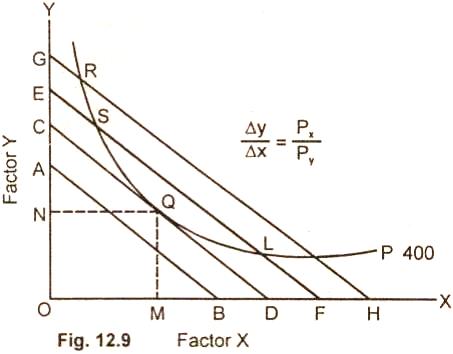Optimum Factor Combination:
Definition:
In the
long run,
all factors of production can be varied. The profit maximization
firm will choose the least cost combination of factors to
produce at any given level of output. The least cost
combination or the optimum factor combination refers to the
combination of factors with which a firm can produce a specific
quantity of output at the lowest possible cost.
Explanation:
There are two methods of explaining
the optimum combination of factor:
(i) The marginal product approach.
(ii) The
isoquant / isocost approach.
These two approaches are now
explained in brief:
(i) The
Marginal Product Approach:
In the long run, a firm can vary the
amounts of factors which it uses for the production of goods. It
can choose what technique of production to use, what design of
factory to build, what type of machinery to buy. The profit
maximization will obviously want to use that mix of factors of
combination which is least costly to it. In search of higher
profits, a firm substitutes the factor whose gain is higher than
the other. When the last rupee spent on each factor brings equal
revenue, the profit of the firm is maximized. When a firm uses
different factors of production or least cost combination or the
optimum combination of factors is achieved when:
Formula:
Mppa = Mppb
= Mppc = Mppn
Pa
Pb Pc Pn
In the above equation a, b, c, n are
different factors of production. Mpp is the marginal physical
product. A firm compares the Mpp / P ratios with that of
another. A firm will reduce its cost by using more of those
factors with a high Mpp / P ratios and less of those with a low
Mpp / P ratio until they all become equal.
(ii) The
Isoquant / Isocost Approach:
The least cost combination
of-factors or producer's equilibrium is now explained with the
help of iso-product curves and isocosts. The optimum factors
combination or the least cost combination refers to the
combination of factors with which a firm can produce a specific
quantity of output at the lowest possible cost.
As we know,
there are a number of combinations of factors which can yield a
given level of output. The producer has to choose, one
combination out of these which yields a given level of output
with least possible outlay. The least cost combination of
factors for any level of output is that where the iso-product
curve is tangent to an isocost curve. The analysis of producers
equilibrium is based on the following assumptions.
Assumptions
of Optimum Factor Combination:
The main assumptions on which this
analysis is based areas under:
(a) There are two factors X and Y in
the combinations.
(b) All the units of factor X are
homogeneous and so is the case with units of factor Y.
(c) The prices of factors X and Y
are given and constants.
(d) The total money outlay is also
given.
(e) In the factor market, it is the
perfect completion which prevails. Under the conditions assumed
above, the producer is in equilibrium, when the following two
conditions are fulfilled.
(1) The isoquant must be convert to
the origin.
(2) The slope of
the Isoquant must be equal to the slope of
isocost line.
Diagram/Figure:
The least cost combination of
factors is now explained with the help of figure 12.9.

Here the isocost line CD is tangent
to the iso-product curve 400 units at point Q. The firm employs
OC units of factor Y and OD units of factor X to produce 400
units of output. This is the optimum output which the firm can
get from the cost outlay of Q. In this figure any point below Q
on the price line AB is desirable as it shows lower cost, but it
is not attainable for producing 400 units of output. As regards
points RS above Q on isocost lines GH, EF, they show higher
cost.
These are beyond the reach of the producer with CD outlay.
Hence point Q is the least cost point. It is the point which is
the least cost factor combination for producing 400 units of
output with OC units of factor Y and OD units of factor X. Point
Q is the equilibrium of the producer.
At this point, the slope of the
isoquants equal to the slope of the isocost line. The MRT of the
two inputs equals their price ratio.
Thus we find that at point Q, the
two conditions of producer's, equilibrium in the choice of
factor combinations, are satisfied.
(1) The isoquant (IP) is convex the
origin.
(2) At point Q, the slope of the
isoquant ΔY / ΔX (MTYSxy) is equal to the slope of
the isocost in Px / Py. The producer gets the optimum output at
least cost factor combination.
Relevant Articles:
|